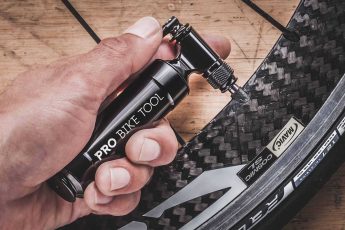Preparing ahead of flat tire incident on the road, an important question every cyclist should ask is “CO² or manual pumps, which is the best option for my road bicycle trip”?
As early as 1649, Otto Von Guericke invented the first manual air pump. This pump was initially known as the spool vacuum sir pump but in the 19th century, it was renamed to be called LEXICON.
The invention of air pumps met rapid Innovation and Technological growth, bringing to the birth of different types of pumps. Different types of air pump which include; Air compressors, bellows, Diaphragm pumps, Rotary vane pumps, Reciprocating pumps, Engine drive tire pumps, and Bicycle tires.
Manual Bicycle pumps were restricted to floor Pumps but innovation brought about the birth of mini-pumps. Mini pumps, however, gave cyclists the opportunity of carrying their pumps around, through rides in case they encounter a flat tire.
Things seemed to get better as CO² Inflator were produced. In 1989, Genuine Innovations became the first bike pump industry to invent a CO² Tire Inflator.
Their lead through this giant step opened a broader pathway for innovation in the world of bike pumps.
CO² inflators are constructed with built-in cartridges containing CO2 gases which are usually replaced after total usage.
These two types of pump are generally good for their purpose, but there are certain areas of consideration which might make a customer choose one over the other.
Different pumps are designed for different functions. Some are good at usage for a bike race, yours, commuting, leisure riding, or even recreational activity.
This article broadens on your ride with a road bike and which pump you should pick up for it.
Road bikes are bicycles specially designed for speed tracks and rides on the road.
Most of them are used by racers for racing, timed events, or indoor sporting activity. Having you at heart, I will be guiding you on your pick for your road bikes.
The manual pump and CO² inflators are individually designed with advantages and disadvantages. One may be better in a particular factor, while the other might be a shopping choice through another angle and view.
The one you make up your mind to choose shouldn’t be as a result of your intuition Or personal preference, but on what activity you are engaging your bicycle with.
However, let’s look at the advantages and disadvantages of each of these pumps as we determine which is better for.your road bike.
MANUAL BIKE PUMP
Quick Navigation
Advantages
1. They have an unlimited pack of air. The supply of air through the pump’s piston does not finish. No matter how years you get to use a manual pump, it will always have air to inflate tires as long as the pumps are in good condition.
2. Lesser Need for Replacement
Manual Pumps are more like your bike’s lifelong asset. They tend to last longer during usage as long as you handle them carefully.
3. Easy to operate
You just need to fit in the pump into your tire’s valve, then keep pumping as you apply pressure on your pump.
.
4. They are way cheaper to manage.
DISADVANTAGES
1. Slow Pumps: Road bike tires usually require a standard pressure of 80-110 PSI. Manual pumps usually release a little amount of air per pressure mounted on them. It will be necessary you consider if you will be able to wait that long during in-between your bike race just to have your tire inflated.
2. They hardly deliver the full pressure your tire needs.
Having a flat tire might be a cumbersome adventure for you using a manual pump, as you will need a lot of pumping to do manually, and a considerable large time frame to achieve your tires PSI.
This will only be seen as a good sign if you are looking forward to having some work out through bike tire pumping.
3. Hardly works for Tubeless tires.
Tubeless tires usually require a large fill of air at a faster rate. Manual pumps that are known for their little provision of air into tires at a slow rate might not be able to deliver such a strong burst of air and a fast rate.
BICYCLE CO2 INFLATOR
CO² Inflator could be classified as a type of mini pump considering their small sizes, but in this scenario, they are manufactured with canisters/ cartridges that have built-in CO².
These cartridges come in different sizes, 16 grams, 20 grams, and 25 grams. This also serves as criteria to determine the amount of gas in a cartridge.
CO² is the only gas that is in inflators as they are larger in molecules than oxygen, hydrogen, or nitrogen, therefore proves to be a better choice in giving you a fast-full tire at shorter intervals.
However, just like its counterpart, there are advantages and disadvantages.
Advantages of using CO² inflators
1. Portability
CO² inflators are small in size and weight. They can easily fit into your pocket while you carry them around as you pedal.
2. Speed Pumping
CO² inflators fill your tire with its required pressure at faster intervals.
3. Fewer efforts are applied to your end during pumping.
In CO² inflators, you just have to attach the inflator head to your Bicycle tire’s valve, pull the trigger on the inflator’s head, and watch your tire achieve a full pump withing 30 seconds.
Disadvantages
1. Cost of Maintenance
CO² cartridges/ canisters are not reusable because they have a limited pack of air supply which is different as in the cases for manual pumps. Once a cartridge has its gas used up, it becomes useless. All you’ll need to do is to replace it by buying a new cartridge and have it attached to your inflator head.
Although cartridges are not that costly, a cyclist embarking on a race is required to ride along with at least 2-3 cartridges for emergencies on the road.
Having started out these stats for you, if you are using your road bike only for the sole intent of racing or speed track events, you might consider CO² inflator a better option.
This decision is after considering its speed of inflation, ease of inflation, size, and Portability, a CO² inflator is what you need for your road bike tire.

